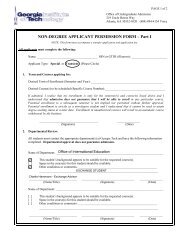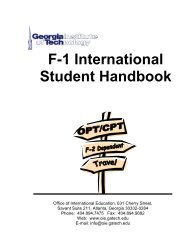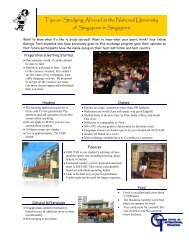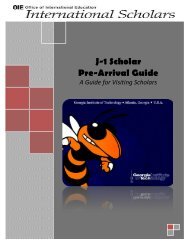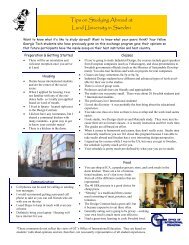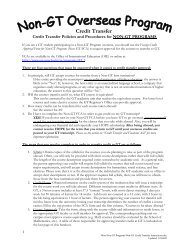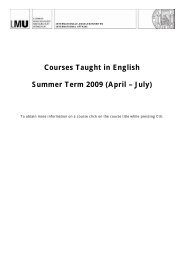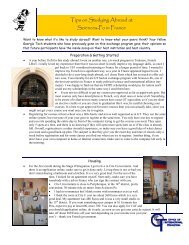J-1 Scholar Pre-Arrival Guide - Office of International Education ...
J-1 Scholar Pre-Arrival Guide - Office of International Education ...
J-1 Scholar Pre-Arrival Guide - Office of International Education ...
You also want an ePaper? Increase the reach of your titles
YUMPU automatically turns print PDFs into web optimized ePapers that Google loves.
Entering the United States<br />
You have a 30 day window <strong>of</strong> opportunity to enter the US as a J‐1 visa holder. You can enter no<br />
earlier than 30 days before the start date <strong>of</strong> your DS‐2019 (#3 <strong>of</strong> the form). If you cannot enter<br />
the U.S. within 15 days after the start date, please contact the administrator in the GT<br />
sponsoring department immediately. They will ensure the DS‐2019 start date is amended avoid<br />
the cancellation <strong>of</strong> your DS‐2019 record in SEVIS.<br />
At the port <strong>of</strong> entry into the U.S., you should be prepared to present your passport, verification<br />
<strong>of</strong> financial support, and signed form DS‐2019 to the immigration <strong>of</strong>ficer. The <strong>of</strong>ficer will record<br />
your arrival to the U.S. with an electronic or paper I‐94 record. The <strong>of</strong>ficer will indicate your<br />
permission to enter the U.S. by stamping your passport for entry, writing your visa status (“J‐<br />
1”), and the designation “D/S” on near the entry stamp in your passport, opposite the visa<br />
stamp. The DS‐2019, passport and I‐94 record are very important to you during your stay in the<br />
U.S. They are pro<strong>of</strong> <strong>of</strong> your legal J‐1 status and you will need them for such purposes as<br />
extending your permission to stay in the U.S., re‐entry to this country after temporary trips<br />
abroad, applying for a Social Security card, and obtaining a Georgia driver’s license.<br />
Canadian Exchange Visitors<br />
Canadian nationals entering the United States as J‐1 exchange visitors do not need to apply for<br />
a J‐1 visa at the U.S. Consulate before entering the U.S. At the pre‐flight inspection area, port<br />
<strong>of</strong> entry or border crossing, the Canadian national need only present a document verifying their<br />
Canadian citizenship, the form DS‐2019, and pro<strong>of</strong> that you have paid the SEVIS I‐901 fee. You<br />
must complete the SEVIS fee payment at www.fmjfee.com prior to requesting admission to the<br />
U.S. and print the receipt. Canadian nationals will also be issued an I‐94 record as evidence <strong>of</strong><br />
lawful admission to the U.S. although it may be a paper document or an electronic record.<br />
Two‐Year Home Residency Rule‐ 212(e)<br />
Some, but not all, exchange visitors are subject to 212(e). Through the residency requirement,<br />
the Department <strong>of</strong> State supports the objective <strong>of</strong> the J visa and ensures your home country<br />
benefits from your educational and cultural exchange activity. If you are subject to 212(e), you<br />
will not be able to change from J‐1 status to another visa status while in the U.S. and will not be<br />
eligible for an H1‐B, L, K or immigrant visa until you have physically resided in your country <strong>of</strong><br />
residence for two years or obtained a waiver from the U.S. Department <strong>of</strong> State. For the terms<br />
<strong>of</strong> the 212(e) requirement, please review your DS‐2019 form and the US Department <strong>of</strong> State<br />
website. Questions about the two‐year home residency requirement, should be directed to<br />
U.S. Consular <strong>of</strong>ficer when you apply for your visa. The OIE will provide additional detail after<br />
you arrive to the US in the J scholar orientation.<br />
5




